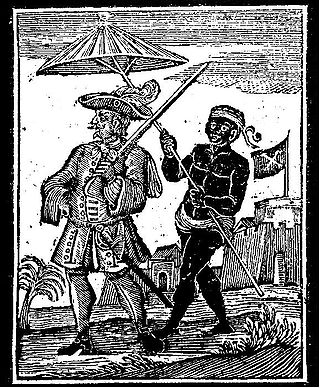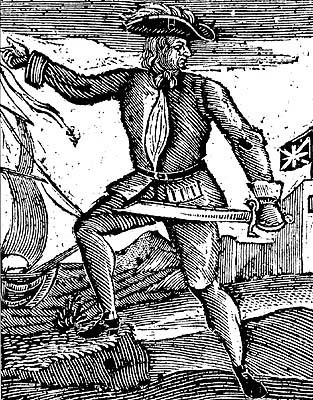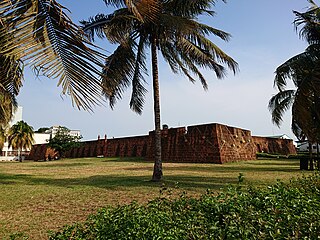Related Research Articles

Condent, born in Plymouth in Devon, was an English pirate who was best known for his piracies in the Indian Ocean.
James Plaintain was a pirate active in the Indian Ocean. He is best known for using his pirate wealth to found a short-lived kingdom on Madagascar.
John Taylor, born Richard Taylor, was an English pirate active in the Indian Ocean, best known for participating in two of the richest pirate captures of all time.

Edward England was an Irish pirate. The ships he sailed on included the Pearl and later the Fancy, for which England exchanged the Pearl in 1720. His flag was the classic Jolly Roger — almost exactly as the one "Black Sam" Bellamy used — with a human skull above two crossed bones on a black background. Like Bellamy, England was known for his kindness and compassion as a leader, unlike many other pirates of the time.

Henry Every, also known as Henry Avery, sometimes erroneously given as Jack Avery or John Avery, was an English pirate who operated in the Atlantic and Indian oceans in the mid-1690s. He probably used several aliases throughout his career, including Benjamin Bridgeman, and was known as Long Ben to his crewmen and associates.

The Golden Age of Piracy is a common designation for the period between the 1650s and the 1730s, when maritime piracy was a significant factor in the histories of the North Atlantic and Indian Oceans.

Charles Vane was an English pirate who operated in the Bahamas during the end of the Golden Age of Piracy.

Howell Davis, also known as Hywel and/or Davies, was a Welsh pirate. His piratical career lasted just 11 months, from 11 July 1718 to 19 June 1719, when he was ambushed and killed. His ships were the Cadogan, Buck, Saint James, and Rover. Davis captured 15 known English and French ships.

Olivier Levasseur, was a French pirate, nicknamed La Buse or La Bouche in his early days for the speed and ruthlessness with which he always attacked his enemies as well as his ability to verbally attack his opponents. He is known for allegedly hiding one of the biggest treasures in pirate history, estimated at over $1 billion, and leaving a cryptogram behind with clues to its whereabouts.
Jeremiah Cocklyn, better known by the name Thomas Cocklyn, was an English pirate known primarily for his association with Howell Davis, Olivier Levasseur, Richard Taylor, and William Moody.
Christopher Moody (1650s-1722) was a pirate as a member of Bartholomew Roberts' crew but was never a captain in his own right. He is best known not for his own actions but for a popular Jolly Roger flag mis-attributed to him as well as for later authors confusing him with unrelated pirate William Moody.
The Pirate Round was a sailing route followed by certain, mainly English, pirates, during the late 17th century and early 18th century. The course led from the western Atlantic, parallel to the Cape Route around the southern tip of Africa, stopping at Madagascar, then on to targets such as the coast of Yemen and India. The Pirate Round was briefly used again during the early 1720s. Pirates who followed the route are sometimes referred to as Roundsmen. The Pirate Round was largely co-extensive with the routes of the East India Company ships, of Britain and other nations.
See also 1718 in piracy, 1720 in piracy, 1719 and Timeline of piracy.
See also 1720 in piracy, other events in 1721, 1722 in piracy and Timeline of piracy.
See also 1719 in piracy, 1721 in piracy and Timeline of piracy.
William Moody was a London-born pirate active in the Caribbean and off the coast of Africa. He is best known for his association with Olivier Levasseur and Thomas Cocklyn, crewmembers who succeeded him as captains in their own right.
Don Benito was a Spanish pirate and guarda costa privateer active in the Caribbean.
William Fox was a pirate active in the Caribbean and off the African coast. He was indirectly associated with a number of more prominent pirates such as Bartholomew Roberts, Edward England, and Richard Taylor.

The Fort Nossa Senhora da Conceição of Lourenço Marques, nowadays known as the Maputo Fortress is located at Praça 25 de Junho and represents one of the main historical monuments of the city of Maputo, former Lourenço Marques, in Mozambique.
References
- ↑ Marley, David (2010). Pirates of the Americas. Santa Barbara: ABC-CLIO. p. 583. ISBN 9781598842012 . Retrieved 17 June 2017.
- 1 2 3 Biddulph, J. (John) (1907). The Pirates of Malabar, and an Englishwoman in India Two Hundred Years Ago. London: SMITH, ELDER & CO. p. 156. Retrieved 17 June 2017.
- 1 2 3 Grey, Charles (1933). PIRATES OF THE EASTERN SEAS (1618-1723). London: PURNELL AND SONS. Retrieved 1 June 2017.
- 1 2 3 4 5 6 7 8 9 Fox, E. T. (2014). Pirates in Their Own Words. Raleigh NC: Lulu.com. ISBN 9781291943993 . Retrieved 17 June 2017.
- 1 2 Johnson, Captain Charles (1724). A GENERAL HISTORY OF THE PYRATES. London: T. Warner. p. 124. Retrieved 18 June 2017.
- ↑ Possibly Sebastião de Andrade Pessanha, 17th Archbishop of Goa, from 1715-1721.
- ↑ Mercure français (in French). Paris: Au bureau du Mercure. May 1722. pp. 61–65. Retrieved 17 June 2017.
- ↑ Humanity, History of. "Pirate Ships | Nossa Senhora do Cabo". www.goldenageofpiracy.org. Retrieved 18 June 2017.
